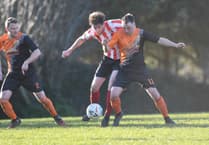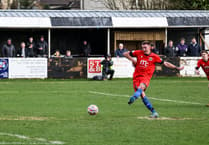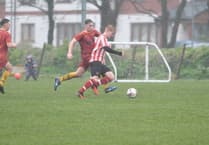With domestic sport currently on hold because of the latest lockdown, reporter and co-author Paul Hatton looks at the history of women’s football in the Isle of Man.
The first article in the series - looking at the inaugural season - was published in the March 16 edition of the Isle of Man Examiner.
In this second installment, Paul looks at women’s football in the island between 2000-2007.
Women’s football was at its most popular locally in 2000-01 with 13 teams, Marown having entered the fold to make it six in Division One and seven in Division Two.
The league operated on a home and away basis with the first set of fixtures starting in August 2000 and finishing in October. The reverse games took place after the Floodlit Cup in March.
The cup competition (now 35 minutes each way) started in late January so there was a break of three months in between.
In Division One, Douglas Royal yet again retained their championship while in the Floodlit Cup it was DHSOB that secured the silverware after beating Rushen United 5-4 in a penalty shootout (having finished 2-2 after extra-time).
In Division Two, Malew, who had missed out on the league title the previous season, clinched the championship when finishing 10 points clear of second-placed Corinthians.
The 2001-02 season proved to be third-time lucky for Rushen when, after finishing two successive seasons as league and Floodlit Cup runners-up, the southerners made sure of the honours.
The Spaniards gained revenge over DHSOB by winning the Floodlit Cup 5-1 - the first time the trophy was won in regulation time compared to penalties - and also clinching the league title after beating Peel 2-1 on April 19. Corinthians won the Division Two title.
It triggered a period of southern dominance and the following season Malew clinched their maiden Division One title while Rushen won the inaugural FA Cup knockout competition when beating Peel 2-0 in the final.
Malew narrowly missed out on winning the Floodlit Cup as well, losing to Union Mills A 0-1 in the final.
Peel won the Division Two championship while Gymnasium were also promoted as runners-up (the only club to do so). That year also saw the first teams withdrawing from the competition, with Union Mills B and DHSOB unfortunately pulling out.
The 2003-04 season saw Rushen clinch their second title, with Douglas Royal back amongst the honours by securing both cup competitions. Marown won their first piece of silverware, winning the Division Two title.
The following campaigns saw dominance from Malew who wrapped up their third successive Division One title as well as securing two Floodlit Cups in a row 2-1 (AET) against Rushen United in 2004-05 followed by a 1-0 win over Douglas Royal in 2005-06. The FA Cup remained elusive for the Clagh Vane side however.
Rushen won their second FA Cup in 2004-05 by beating Division Two champions Corinthians 7-0 - a record scoreline in the final. Interest from the north saw Michael United and Ramsey enter teams for the first time.
In the following campaign Malew went close to completing the treble, agonisingly losing the FA Cup to Royal 2-3 in the final.
It was the only time the FA Cup qualifying rounds were played on a home and away basis. Gymnasium won the Division Two title.
The 2006-07 season saw the three trophies being shared, with Rushen winning their second Floodlit Cup when beating an improving Corinthians in a penalty shootout. Royal retained the FA Cup when defeating Rushen 2-0 in the final.
Castletown continued the southern run of success by winning the Division Two championship, while Colby made their introduction to women’s football.
Women’s/girls’ football within schools was introduced during this time and the 2003-04 season saw the inaugural junior girls’ competition.
Corinthians won all three trophies by completing the season unbeaten and, in doing so, laid the foundations for their future success.
The women’s representative side saw competitive action during the 2001 NatWest Island Games (the first occasion that women’s football was included) with the Isle of Man being the hosts.
Their inaugural match was at Ballacloan Stadium, Ramsey when the home side lost 0-11 to the strong Faroese, with the Earl and Countess of Wessex in attendance.
The Manx side recovered to reach the semi-finals of the competition by beating Ynys Mon 5-1 in the remaining group match. But they then lost 1-11 to Aland in the final four before narrowly missing out on the bronze medal when losing 2-3 to Jersey.
The 2003 Guernsey Island Games was a tournament to forget for the Isle of Man team as they finished with the wooden spoon.
In Shetland two years later (the only time it was played in a league format), they beat the hosts 4-0 and FIFA-seeded Bermuda 2-1, but defeats to the Faroes, Aland and ultimately Guernsey saw them again miss out on the medals.
The 2007 Games in Rhodes saw the Manx play Gotland twice in the group stages. The matches took place in stifling heat that included a water break half-way through each half.
After losing 1-2 in the first match they beat the Scandinavians 3-1 in the return game, thus qualifying for a place in the final four.
In the semi-finals, Isle of Man lost 0-2 to Aland (in a match referred to as ’the bras and bibs’) before the bronze medal play-off against Bermuda finished goalless in normal time. The Manx missed out again when losing 3-4 in the penalty shoot-out.
But success did come in the Umbro Cup in 2006 - a tournament played over one weekend at the Manchester Armitage Centre - when the Manx women beat Acton 1-0 in the final.
The next episode in this series: the beginning of the Noble’s Park/Ballafletcher dominance




